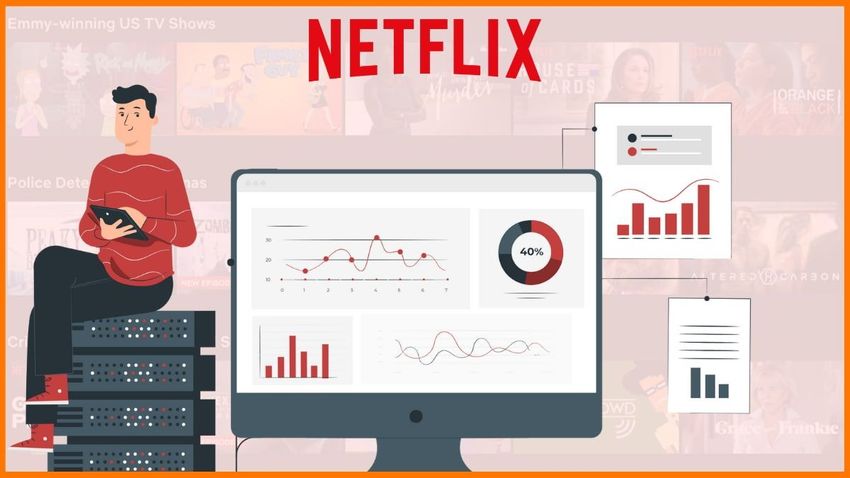If you’ve ever binged your favorite series on Netflix, you’ve likely been amazed (or slightly freaked out) by how accurate the platform’s recommendations are. From suggesting what to watch next to curating entire categories based on your tastes, Netflix uses cutting-edge artificial intelligence (AI) to keep you glued to your screen. But how does it all work? Let’s dive behind the scenes of Netflix’s AI recommendation engine.
The Core of Netflix Recommendations: Data
At the heart of Netflix’s recommendation engine is data—a lot of it. Every click, pause, and search you perform on the platform generates valuable information about your preferences. Some of the key data points Netflix tracks include:
- Viewing history: What shows or movies you’ve watched and completed.
- Interaction data: Titles you’ve searched for, rated, or added to your list.
- Watch time: How long you watch certain content and when you drop off.
- Device preferences: Whether you’re watching on a phone, tablet, TV, or laptop.
With millions of users generating this data every day, Netflix has one of the most robust datasets in the entertainment industry.
How Netflix Uses AI: The Algorithms in Action
- Personalization Algorithm
- Netflix uses AI models to personalize content recommendations for each user. The platform doesn’t just suggest the most popular titles; instead, it considers what’s most relevant to you. For example:
- If you’re into romantic comedies, Netflix will recommend more rom-coms, but with diversity in settings and themes to keep you engaged.
- If you binge multiple episodes in a single sitting, it will prioritize content with a similar pacing.
- Collaborative Filtering
- Netflix employs a method called collaborative filtering, which groups users with similar viewing habits. If User A and User B both love action movies and thrillers, Netflix assumes they might also like other titles that are popular within that group.
- Content-Based Filtering
- In addition to user behavior, Netflix analyzes the characteristics of content itself—genres, actors, directors, themes, and even subtitles. For example:
- If you loved Stranger Things, the algorithm might suggest The Umbrella Academy, based on shared themes like sci-fi and supernatural elements.
- Deep Learning for Visual and Audio Analysis
- Netflix takes AI a step further by analyzing visual and audio elements of its content. AI models examine:
- Thumbnails and visuals: Which cover art grabs the most attention.
- Soundtracks: How musical scores or sound effects influence viewer engagement.
- Scene composition: Analyzing lighting, colors, and pacing to understand mood and tone.
- Contextual Bandits
- Netflix uses a sophisticated machine learning model known as contextual bandits to optimize recommendations in real time. This model balances:
- Exploiting what it already knows you like (e.g., suggesting a trending show in your favorite genre).
- Exploring new titles to expand your interests (e.g., introducing a new genre or niche content).
How Netflix Keeps It Fresh
- Dynamic Thumbnails
- Have you noticed how the cover art for a show or movie changes? That’s not a coincidence. Netflix’s AI analyzes which thumbnail is most likely to catch your attention based on your past interactions. If you’re into action movies, you might see a cover with intense explosions, while someone else sees a romantic moment from the same film.
- Regional Customization
- Netflix customizes recommendations based on your geographic location. AI ensures that cultural preferences, trending shows, and regional content are prioritized.
- Trending and Social Influence
- AI identifies what’s currently trending on a global or local scale and incorporates it into your recommendations. For example, if Wednesday is making waves online, Netflix ensures it shows up prominently on your homepage.
Challenges Netflix Faces
- Overwhelming Choices
- With thousands of titles in its library, Netflix runs the risk of overwhelming users with too many options. To combat this, AI creates hyper-personalized categories like “Feel-Good Movies” or “Because You Watched…” to organize content better.
- Avoiding Echo Chambers
- If the algorithm only recommends content similar to what you’ve already watched, it could create a “content bubble.” Netflix tries to counter this by occasionally suggesting diverse or unexpected titles.
- Privacy Concerns
- Since Netflix collects vast amounts of user data, privacy is always a concern. The company uses anonymized data to protect user identities while still delivering personalized experiences.
The Future of Netflix’s AI Recommendations
Netflix’s AI technology is constantly evolving. In the future, we might see:
- Hyper-personalized storytelling: Where viewers can customize the plot of a show based on their preferences (think interactive content like Black Mirror: Bandersnatch).
- Predictive analytics: AI that suggests what you’ll want to watch before you even open the app.
- Virtual reality integration: Personalized VR experiences where AI creates immersive, interactive entertainment tailored to you.
Final Thoughts
Netflix’s recommendation system isn’t just about algorithms—it’s about understanding human behavior. By combining advanced AI with human-centric design, Netflix ensures you always find something worth watching. The next time you settle in for a Netflix binge, you’ll know there’s a world of data and AI working behind the scenes to keep you entertained.


